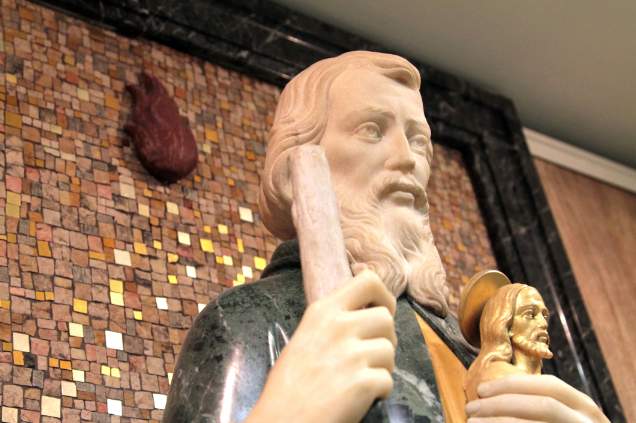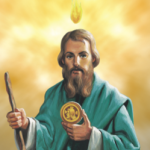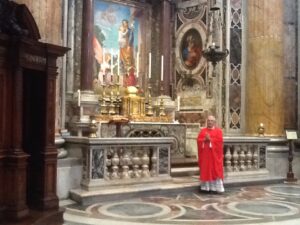Patron Saint of the Impossible
St. Jude Thaddeus, The Patron Saint of the Impossible
 Legend has it that St. Jude was born into a Jewish family in Paneas, a town in the Galilee region of ancient Palestine, the same area that Jesus grew up in. He probably spoke Greek and Aramaic, like many people in that area, and he was a farmer by trade. Jude was described by St. Matthew (13:55) as being one of the "brethren" of Jesus, probably meaning a cousin since the Hebrew word for "brethren" indicates a blood relationship. His mother, Mary, was referred to as a cousin of Jesus' mother Mary, while his father, Cleophas, was the brother of St. Joseph.
Legend has it that St. Jude was born into a Jewish family in Paneas, a town in the Galilee region of ancient Palestine, the same area that Jesus grew up in. He probably spoke Greek and Aramaic, like many people in that area, and he was a farmer by trade. Jude was described by St. Matthew (13:55) as being one of the "brethren" of Jesus, probably meaning a cousin since the Hebrew word for "brethren" indicates a blood relationship. His mother, Mary, was referred to as a cousin of Jesus' mother Mary, while his father, Cleophas, was the brother of St. Joseph.
Jude had several brothers, including St. James, who was another of the original Apostles. His own first name, "Jude", means giver of joy, while "Thaddeus", another name he was called, means generous and kind.
Jude was called to be one of the twelve Apostles of Jesus Christ. He began preaching the Good News of Jesus to Jews throughout Galilee, Samaria, and Judea. Around 37 A.D., St. Jude went to Mesopotamia (present-day Iraq) and became a leader of the Church of The East that St. Thomas established there. St. Jude traveled throughout Mesopotamia, Libya, Turkey, and Persia with St. Simon, preaching and converting many people to Christianity. He was credited with helping the early creation of the Armenian Church and other places beyond the borders of the Roman Empire.
Around the year 60 A.D., St. Jude wrote a Gospel letter to recent Christian converts in Eastern churches who were under persecution. In it, he warned them against the pseudo-teachers of the day who were spreading false ideas about the early Christian faith. He encouraged them to persevere in the face of the harsh, difficult circumstances they were in, just as their forefathers had done before them. He exhorted them to keep their faith and to stay in the love of God as they had been taught. His inspirational support of these early believers led to him becoming the patron saint of desperate causes.
 St. Jude is traditionally depicted carrying the image of Jesus in his hand. This depiction comes from a Biblical story in which King Abgar of Edessa (a city located in what is now southeast Turkey) asked Jesus to cure him of leprosy and sent an artist to bring him a drawing of Jesus. Impressed with Abgar's great faith, Jesus pressed his face into a cloth and gave it to St. Jude to take to Abgar. Upon seeing Jesus' image, The King was cured and he converted to Christianity along with most of the people under his rule.
St. Jude is traditionally depicted carrying the image of Jesus in his hand. This depiction comes from a Biblical story in which King Abgar of Edessa (a city located in what is now southeast Turkey) asked Jesus to cure him of leprosy and sent an artist to bring him a drawing of Jesus. Impressed with Abgar's great faith, Jesus pressed his face into a cloth and gave it to St. Jude to take to Abgar. Upon seeing Jesus' image, The King was cured and he converted to Christianity along with most of the people under his rule.
In addition to the image of Christ, St. Jude is often shown in paintings with a flame around his head. This represents his presence at Pentecost, when he received the Holy Spirit with the other apostles.
St. Jude died a martyr of God in Persia or Syria around 65 A.D. After his death, his body was brought back to Rome and was placed in a crypt beneath St. Peter's Basilica. His last mortal remains still lie there today. After his martyrdom, pilgrims came to his grave to pray, and many of them experienced the powerful intercessions of St. Jude. This is how he got the title, “The Saint for the Hopeless and the Despaired”. St. Bridget of Sweden and St. Bernard had visions from God asking each to accept St. Jude as “The Patron Saint of the Impossible”. St. Jude Shrine in Baltimore has arranged for a daily Mass to be celebrated on the altar above the tomb for the intentions of those whose names are registered at the Shrine. Pope Paul III, in a brief dated September 22nd, 1543, granted a plenary indulgence to all who would visit his tomb on the day commemorating his death, October 28th, the day of his feast.
Today, more than ever before, the merit of Jude Thaddeus is being revived in people’s minds and hearts. In return, he is proving himself to be more than an ordinary advocate, taking special delight in coming to the aid of persons in desperate need. No petition seems too great for him. In response to the many requests and petitions received, the Pallottines offer daily prayers and bear witness to the many favors received through St. Jude’s intercession.

